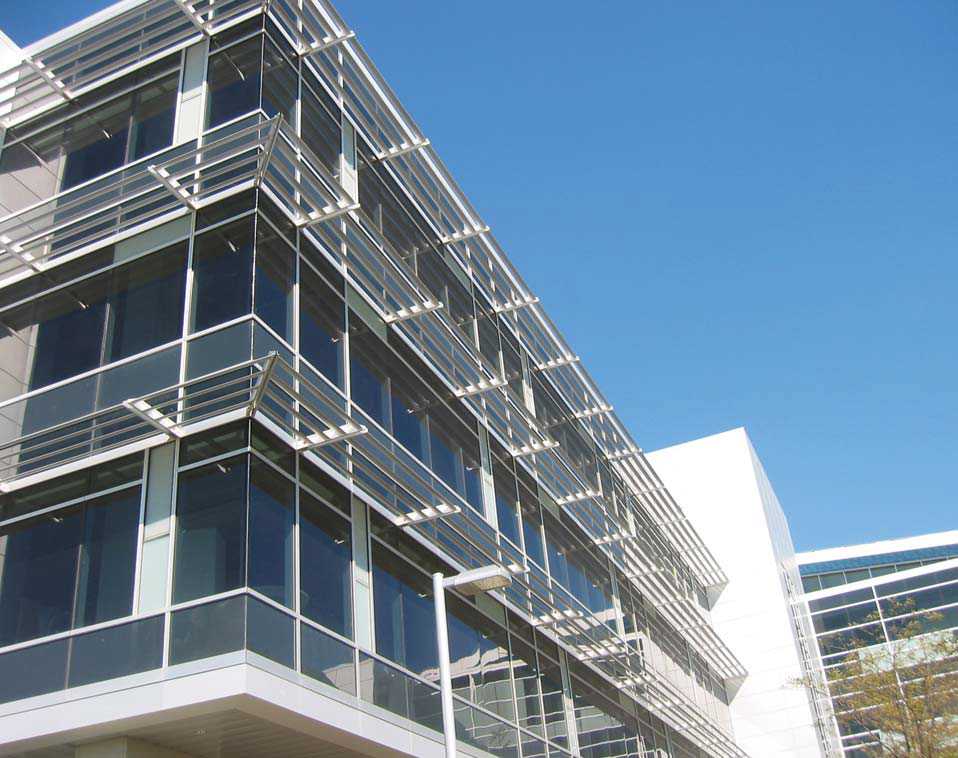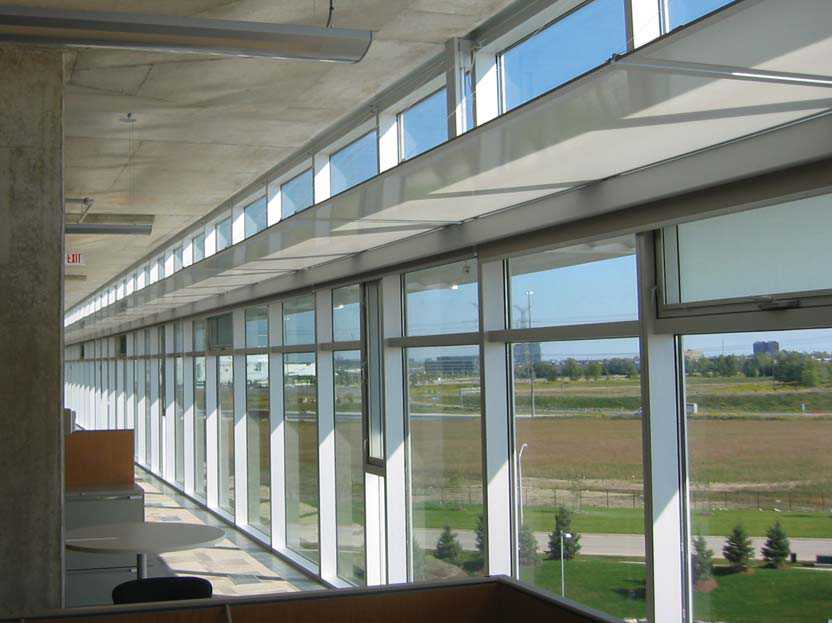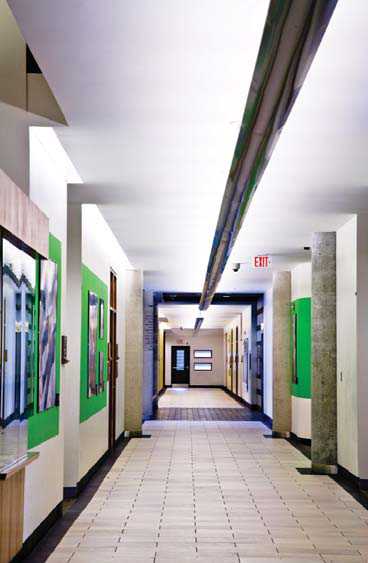Types of Lighting
There are six principal types of lighting:
- Natural Daylight
- Incandescent Lighting
- Fluorescent Lighting
- Tungsten-Halogen Lighting
- LED Lighting
- High-Intensity Discharge (HID) Lighting
Each one affects people impacted by blindness in different ways.
Both natural light and artificial lighting can cause glare, which can literally blind a person living with blindness. The effects of glare are compounded when high-gloss materials are used. Use low-lustre finishes for all vertical and horizontal surfaces.
Natural Daylight


Natural daylight is the source by which all other light sources are judged. Its use has advantages and disadvantages. Although daylight is widely accepted as having a positive psychological effect on people, outdoor luminance varies greatly – it can be as high as 120,000 lux when there is direct sunlight at noon, which can be painful to look at, or it can be as low as five lux when there are storm clouds and the sun is on the horizon. People impacted by blindness may have problems adapting to different amounts of natural light on days that are intermittently sunny and cloudy.
Natural daylight is one of the greatest causes of glare and shadow in building interiors. Inside a building, daylight should be diffused and even, without causing glare or shadowing. Both can be problematic for people impacted by blindness. Effective methods to control glare and shadow include tinted window glass, translucent wall panel systems and exterior awnings and canopies. Special films that reduce solar and visible radiation can be installed on existing windows and glazing.
People impacted by blindness experience difficulty moving between areas where there is great contrast in light levels. It’s important to moderate light levels, especially near entrances. Interior and exterior light levels should be as close to equal as possible.
Consider the effects of natural lighting and shadowing when deciding where to place items such as entrance canopies and staircases. Entrance canopies can be effective in reducing glare from natural light sources, but they can also hide the entrance from the view of a person with blindness. Similarly, staircases located outside should be in clear view at all times and never shadowed by canopies or other objects.
For buildings, there are many ways to mitigate both glare and solar heat gain. Exterior sunshades protect the exterior skin from direct exposure and eliminate glare. Interior window coverings with a maximum of three per cent open fabric (one per cent is recommended for western exposures) can be automated to respond to glare conditions. Computerized control systems allow the glare condition to be defined to suit users of the occupied spaces and can be easily modified if the use changes.
Natural lighting can be enhanced with the use of light shelves, which are horizontal planes or a series of parabolic louvres about 2,280 mm off the finished floor that bounce indirect light off the ceiling and deeper into the building.
Using these in tandem with automated artificial lighting controls (i.e., that turn off light fixtures when there is enough natural light) is effective in creating more indirect light that is free of glare. It also saves energy.
Skylights and other sources of natural light should be positioned so that sunlight does not shine directly into an interior space. If this isn’t possible, use tinted glazing or incorporate a shading device.
Incandescent Lighting
Incandescent lighting is produced by light bulbs that give off both heat and light and is a good alternative to natural light. Because its colour spectrum is closer to natural light than many other light sources, it was traditionally the preferred source for general-purpose illumination.
However, incandescent bulbs are energy inefficient and are being replaced in many applications by devices such as fluorescent lamps, HIDs and LEDs, which give more visible light for the same amount of electrical energy input. Some jurisdictions are attempting to ban the use of incandescent light bulbs in favour of more energy-efficient lighting.
Fluorescent Lighting

Fluorescent lighting consumes less electricity, lasts longer and does not radiate as much heat as incandescent bulbs. It can come in the form of tubes that create a line of light, which is the traditional lighting environment in large buildings and offices. It can also come in the form of bulbs, known as Compact Fluorescent Lamps (CFLs). CFLs provide good overall light and are increasingly popular in the built environment. Many jurisdictions encourage their use as an energy-saving measure through incentive programs and legislation.
A fluorescent tube is a more diffuse and physically larger light source than an incandescent lamp. In suitably designed lamps, fluorescent light can be more evenly distributed without a point source of glare as produced by an incandescent filament.
Fluorescent lighting has a major disadvantage in the slight flicker it produces. There are several ways to counteract this effect. Use proper lenses or shield the light source to provide even, indirect lighting. Or, use two tubes operating in phase opposition. These fixtures produce a substantially reduced flicker when used as an indirect light source or combined with prismatic diffusion covers, lattices, translucent shades or cover panels.
Today, most offices have well-designed lighting. Banks of overly bright, improperly shaded fluorescents are becoming a thing of the past.
Fluorescent lighting now comes in a range of shades in the light spectrum. The cool “blue” tones of the past were not a good match for natural or incandescent light. Today’s better formulations of phosphor inside the tubes provide warmer tones. The best “soft” or “warm” white fluorescent bulbs available now are similar in colour to standard incandescent lighting.
Dimmable fluorescent lighting fixtures, which use electronic ballasts working at a high frequency, will reduce both the flicker of light and energy consumption. Reduced flickering is less tiring and distracting for older adults and people impacted by blindness – particularly those who rely on peripheral vision.
If using a linear arrangement of fluorescent lighting in corridors, designers can take advantage of their directional attribute by installing the tubes in one of two ways:
- Centre: Placing the light fixture in the middle of the corridor provides a visual cue for orientation by helping to define the right and left sides of the corridor. This can be achieved by either indirect or direct lighting. In the case where indirect lighting is used, the centre of the corridor ceiling appears as a dark line with even, diffused, indirect and glare-free light on the ceiling.
- Sides: Placing light fixtures at the two sides of the corridor where walls meet the ceiling provides a similar visual cue that defines the width of the passageway and facilitates navigation. In this case, the lighting is indirect - the fluorescent tubes are tucked into valances or light coves along the sides. The bulbs are not visible and the cove system produces an acceptable “soft” light effect.
Tungsten-Halogen lighting
Tungsten-halogen lighting is a type of incandescent lighting where a bulb’s filament is surrounded by an inert gas and a small amount of halogen, which makes the bulb more efficient and increases its lifespan.
Halogen lighting produces a bright white light and provides more light per watt than regular incandescent bulbs, making it a good source of task lighting. Because halogen lights are so bright, the positioning of light bulbs needs to be considered to reduce glare and shadow.
Halogen lights also give off a great deal of heat, which is an important safety consideration in any built environment. Don’t position halogen lights in an area beneath which someone with blindness might inadvertently sit or stand and be injured from the heat. If sight is required to notice the danger, either the lights should be moved out of the way or a barrier (e.g., a railing) should be used to prevent injury.
Light-Emitting Diode lighting
LED lighting emits an energy-efficient source of light when electricity is applied to a simple circuit. LED bulbs produce light that is very similar to daylight, making these bulbs practical.
They are frequently used as a directional light source, to focus light on an object or building element such as a sign or reception desk. LEDs can also be configured in arrays within bulbs, providing multi-directional illumination similar to that produced by incandescent bulbs.
LED bulbs produce no ultraviolet (UV) radiation and little heat, making them ideal for illuminating objects that are sensitive to UV light, such as works of art.
Traditionally used as indicator lights on electronic devices, LED bulbs are now used in wider applications including signage, streetlamps and architectural detail lighting. LED lighting is also used as task or spot lighting (e.g., under kitchen cabinets to illuminate countertops).
LED Sources:
- Light up instantly
- Can be easily dimmed
- Operate silently
- Require only a low-voltage power supply (which increases safety)
- Are increasingly more common and affordable
High-Intensity Discharge lighting
HID bulbs are a type of arc lamp that have a longer life and provide more light (lumens) per watt than any other light source. They are available in mercury vapour, metal halide, and high- and low-pressure sodium types.
Low-pressure sodium vapour lamps are extremely efficient. They produce a deep yellow-orange light and have an effective colour rendering index of nearly zero. Items viewed under their light appear monochromatic, which has implications for people impacted by blindness. Metal halide and ceramic metal halide lamps can be made to give off neutral white light, which is useful for applications where normal colour appearance is critical (e.g., TV and movie production, indoor or night-time sports games, automotive headlamps and aquarium lighting).
High-pressure sodium lamps tend to produce a much whiter light, but still with a characteristic orange-pink cast. New colour-corrected versions producing a whiter light are available, but some efficiency is sacrificed for the improved colour.
HID lamps are typically used in large areas that require high levels of overhead light and when energy efficiency and/or light intensity are desired (e.g., gymnasiums, large public areas, warehouses, movie theatres, football stadiums, outdoor activity areas, roadways, parking lots and pathways). More recently, HID lamps, especially metal halide, have been used in small retail and residential environments. HID lamps have made indoor gardening practical, particularly for plants that require a good deal of high-intensity sunlight.
 Back to Top
Back to Top